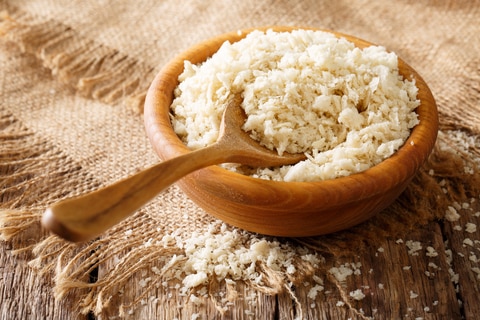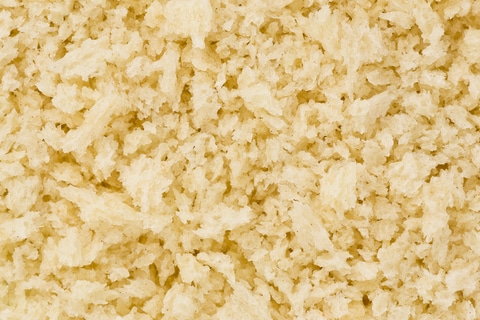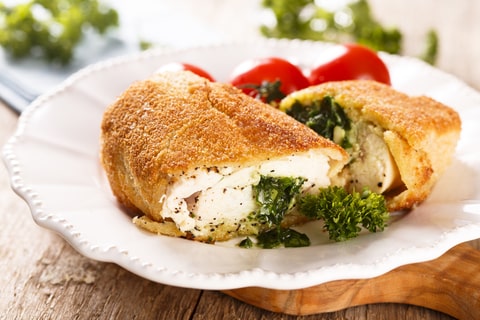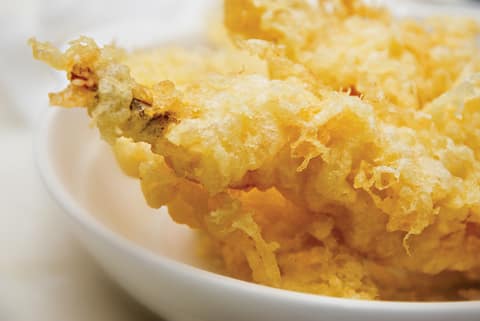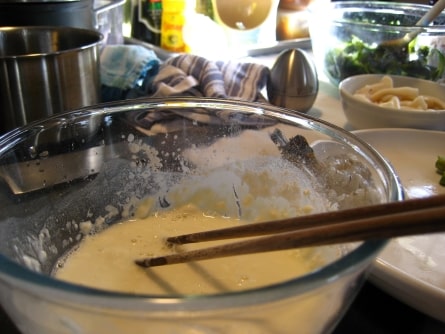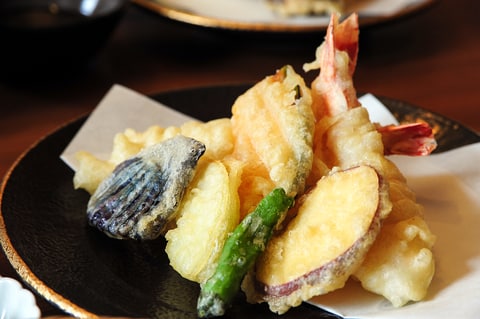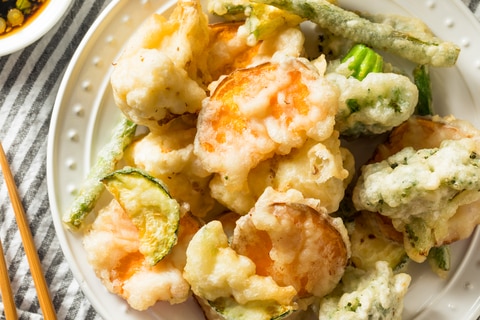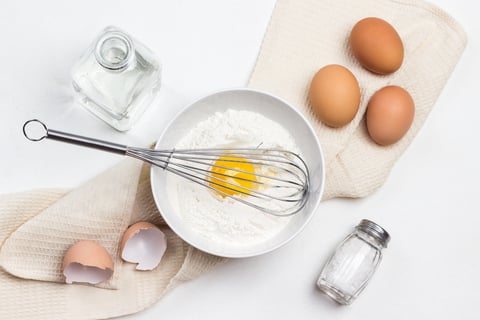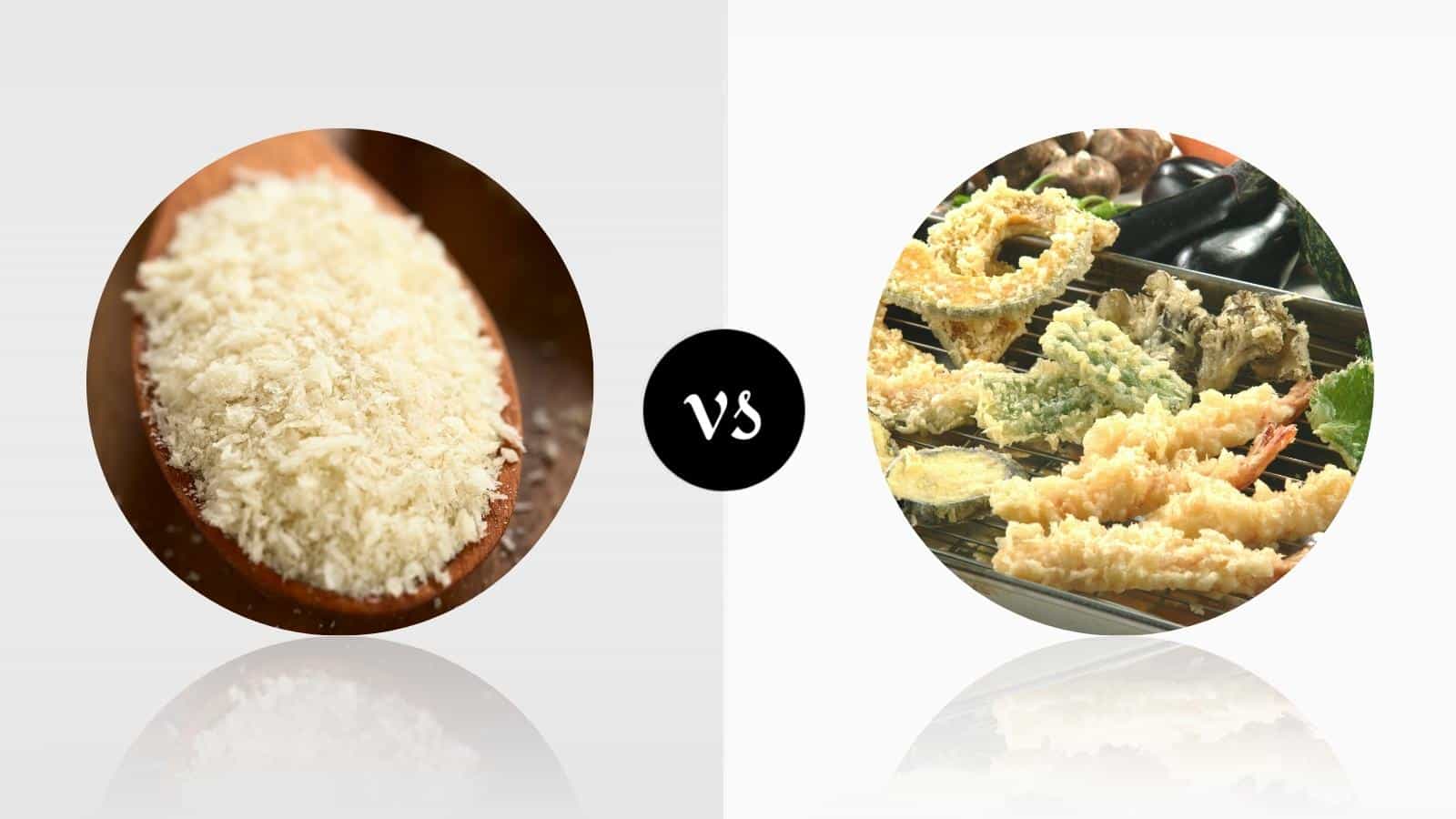
Who doesn’t love a good crispy coating? Especially when it’s something like marinated chicken that’s then been crumb coated in panko?
Or perhaps, those mouth-watering tempura prawns catch your fancy. If you’re wondering whether panko and tempura are the same things, read on.
We’ve got everything you need to know about panko vs. tempura coming up in our comprehensive comparison.
Panko Vs. Tempura Comparison
| Panko | Tempura | |
|---|---|---|
| Ingredients | Japanese Milk Bread Crumbs With Crusts Removed That's Been Processed In A Grinder Into Coarse, Large, Light Crumbs | Flour, Eggs, Ice Water | MSG, Sparkling Water & Combination Flours (Blending Wheat, Rice, Tapioca Starch & Cornstarch) |
| Consistency | Large, Coarse, Light, Airy, Flakey With Shape Resembling Shard | Light And Crunchy Coating With Greater Crunchiness Than Panko And Snap To Texture And Mouthfeel - Crumbles Easily |
| Flavor | Lightly Toasted Crumbed Flavor That's Mild And Versatile - Doesn't Absorb Other Tastes Easily | Neutral Flavor That Draws Taste From The Food Being Battered |
| Best Uses | Coating Presentation-Worthy Food, Granting Great Texture To Coatings | High-Heat Deep-Frying In Sesame Oil |
| Shelf-Life | 6 Months | Best Made Fresh - Lasts Refrigerated For Up To 3 Days |
| Substitutes | Regular Crustless Bread Crumbs | Any Basic Batter With Ice Water, Egg And Flour |
| Considerations | Panko Is Perfect For All Dishes Except When You're Looking For A Soft, Non-Crunchy Coating | Air Frying Requires Tempura Batter To Be Chilled To Icy Temperature Or It Doesn’t Stick Properly |
Panko vs Tempura
Once you’re familiar with these two popular types of coating covered in our upcoming evaluation, you’ll always know which is best between panko and tempura for your next meal.
Each delivers the perfect crispiness and texture that food needs to come out looking and tasting great.
Panko
Most cooks find that they’ll never go back to regular breadcrumbs after trying panko. Panko, or Japanese breadcrumbs, are what stunning restaurant food is made of.
There’s no crumbed coating that has the texture, clean appearance, or delicious-looking degree of browning and crispness. Let’s take a closer look at what makes panko such a prevailingly popular choice.
What Is Panko Made Of?
Panko is coarse bread crumbs made entirely of light, low-density Japanese milk bread inclusive of an additive called tang zhong with its crust removed that’s been dried and then processed in a meat grinder, unlike regular breadcrumbs, which are chopped in a food processor or similar mill.
Consistency
You’ll find that panko breadcrumbs are larger, coarser, lighter, airier, and flakier than regular breadcrumbs, with each carrying a uniform shape that resembles a shard.
Their unique texture means that panko absorbs less oil than other varieties like normal or Italian crumbs. Food crumbed in panko has a lighter texture than tempura batter.
Flavor
By itself, panko has very little flavor at all. It tastes like the lightest, airiest, fluffiest neutral crumbs you’ve ever tasted, with a lightly toasted bread flavor that lacks the yeastiness of other crumbs.
One of the best characteristics of panko is that it doesn’t absorb flavor from the oil that it’s being fried into any significant degree, thanks to the tiny air pockets present that allow the coating to cook quickly without drawing external tastes.
Best Uses
Even after frying or baking, panko crumbs hold their shape. This makes them ideal for meals where it’s all about the presentation. Panko crumbs can be used to coat all types of food, but they’re best suited to coating chicken.
After all, there’s nothing like a well-cooked Chicken Kiev. Panko’s just as great for coating fish, fish fingers, and other types of seafood.
Even if you intend on deep frying your fish, don’t worry about the color darkening. Panko doesn’t turn brown very quickly.
Shelf Life
Panko breadcrumbs last for eight to ten months when properly stored as opposed to the five to six months offered by regular breadcrumbs.
Panko Substitutes
If you can’t find any panko crumbs at the supermarket, you can always make some at home.
Just remove the crust from any available white bread, grind the bread together and let it bake for 15 minutes while ensuring that they don’t toast past a light shade of white with a silvery hue.
The best bread is homemade Japanese milk bread, but any bread will do in a pinch. Try freezing the loaf before baking to make crumbing it easier.
Considerations
The only time that you won’t want to use panko over regular breadcrumbs or another variety like Italian breadcrumbs is when you are looking for a coating that isn’t ultra-crispy.
Panko always fries to a crunchy coating that’s extra crispy, so keep this textural prominence in mind when picking out suitable crumbs for your recipe.
Tempura
Tempura batter mix is not the same as panko. The only similarity is the degree of crunchiness obtained when frying food in either coating but crumbed and battered are two completely different textures and tastes.
Here is a breakdown of tasty tempura batter, all its defining traits, and when it’s best used.
What is Tempura Made Of?
Tempura is a rich batter made up of flour, eggs, a raising agent like baking soda or baking powder, and a selection of herbs to incorporate flavor. The secret to a good tempura batter is ice water.
The cold effect of ice water makes the batter light and fluffy. White wheat flour alone is common, tempura mixtures typically combine wheat flour, rice flour, and tapioca starch.
Many choose to add MSG as a flavor enhancer and opt for chilled sparkling water, seltzer, or soda water to make the batter even lighter and crispier.
Consistency
Fried food coated in tempura batter comes out with an extremely light and crunchy coating. The crispiness is greater than panko, with a definite snap to its texture and mouthfeel.
Even though tempura-coated food comes out crispy with a crackly crunch, the crunchiness is never hard to eat but rather cracks and dissipates in your mouth without posing a chewing challenge.
Flavor
While the batter itself has a light, neutral flavor reminiscent of cornstarch, tempura batter derives its flavor from the food item being coated.
The way that tempura draws taste from the shrimp, chicken, mushrooms, or other vegetables/food being fried is one of its best qualities.
Best Uses
Unlike panko crumbs, tempura-coated items brown very quickly. You just can’t fry them in hot oil for an extended duration.
While panko crumbs can be fried in any oil, a high smoke point oil like sesame is preferable for tempura coating.
Frying tempura batter in sesame oil doesn’t brown the coating as quickly as canola or sunflower oil. You can coat just about anything in tempura batter, but it is famously used on fish, seafood like prawns and shrimp, and to coat vegetables.
Vegetable tempuras are called Yasai Tempura, and just about any vegetables from capsicums to carrots, mushrooms, potatoes, and any other veggie preferred can be tempura coated and fried.
Shelf Life
As a batter, tempura is best made fresh. However, restaurants and those preparing great volumes of food can store their tempura batter in the refrigerator for up to three days.
After storage in the fridge, one will need to first stir, whisk or press out any lumps that have formed.
Tempura Substitutes
All that tempura batter essentially is, is a mix of flour, egg, and ice water so opt for any flour you prefer and stick to the coldest water possible, and you’ll always come out with a coating that’s close to a traditional tempura mix.
Considerations
Air frying may have revolutionized the world of deep-frying, but it doesn’t work so well with a tempura coating.
If the tempura isn’t sticking and you find pieces falling off, leaving your battered food unevenly coated, your batter isn’t cold enough.
Add a few ice cubes to the mix or chill the batter in the freezer for a few minutes to make it fluffier, which improves its ability to cling and coat.
What Is The Difference Between Panko And Tempura Batter?
The main difference between panko and tempura is that panko is high-quality, light, and fluffy Japanese bread crumbs used for a coating that is made from a specific type of milk bread native to Japan with its crusts removed, whereas tempura is a batter for deep frying that relies on flour, egg and ice water for its crunchy coating.
Which Is Best Between Panko Vs. Tempura?
When it comes to panko vs. tempura, there is no clear winner but rather two outstanding ingredients that excel in their own right. Panko is the best for anything crumbed, whereas tempura is a batter that fries to a crunchy coating.
Certain foods are better crumbed, whereas others suit a crispy, smooth battered coating instead. It’s all up to you and what you’re making.
